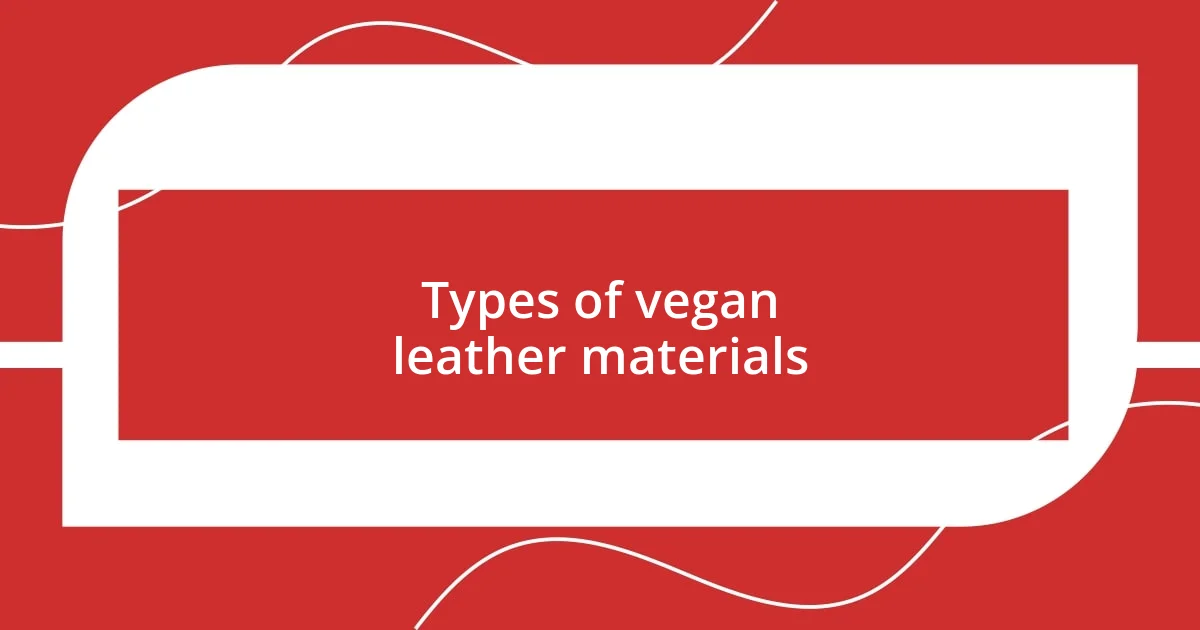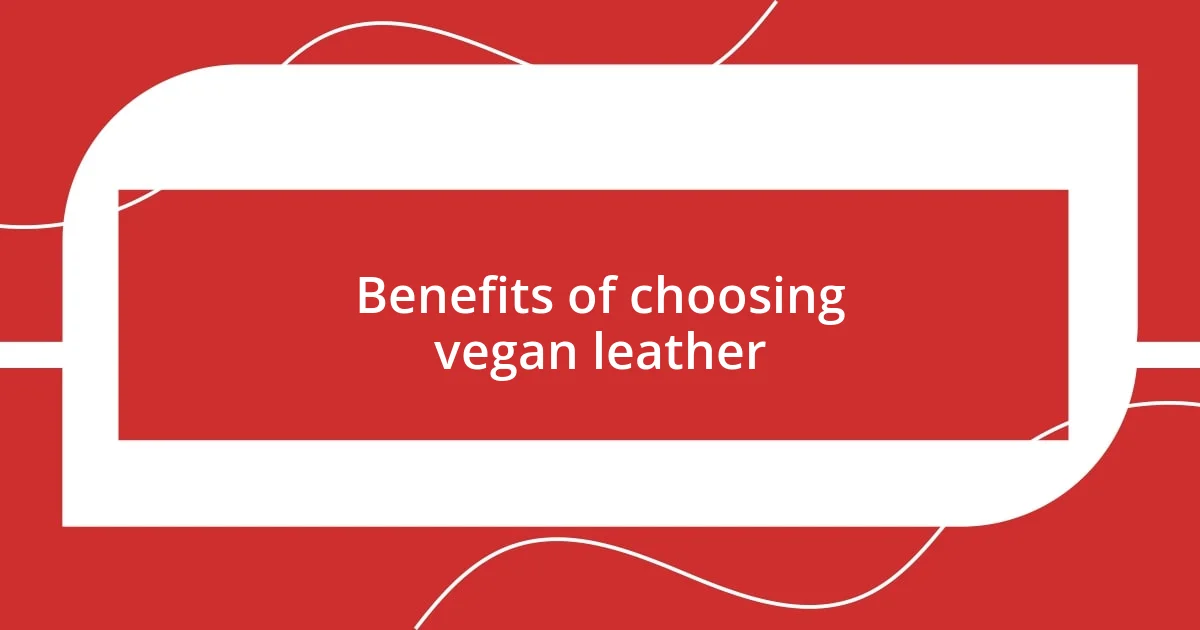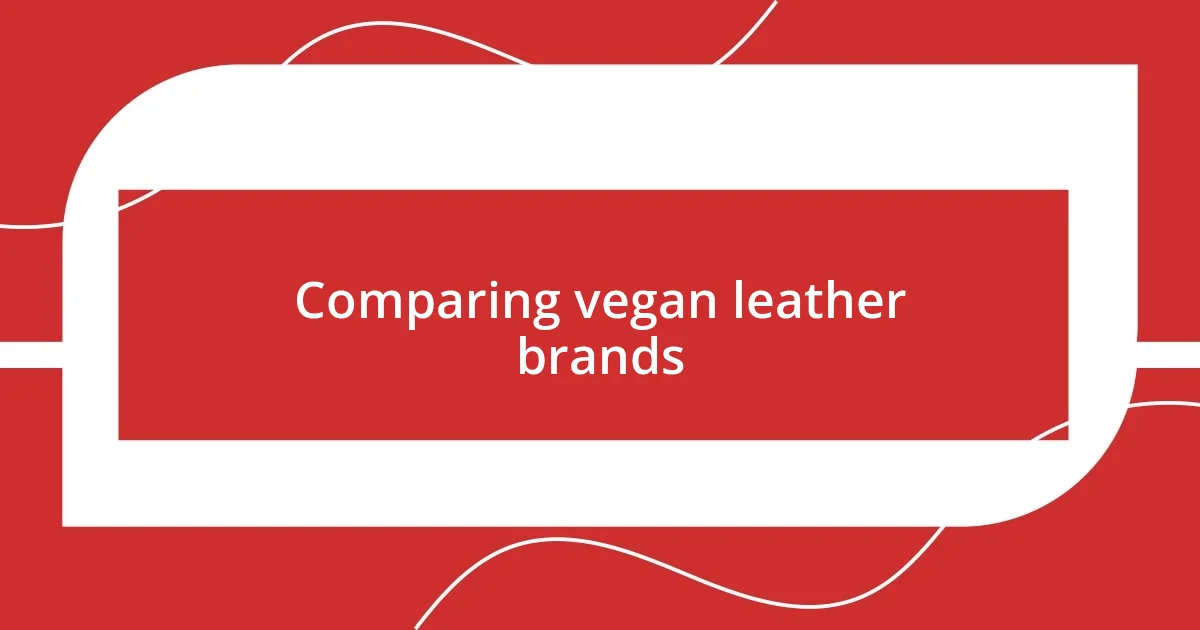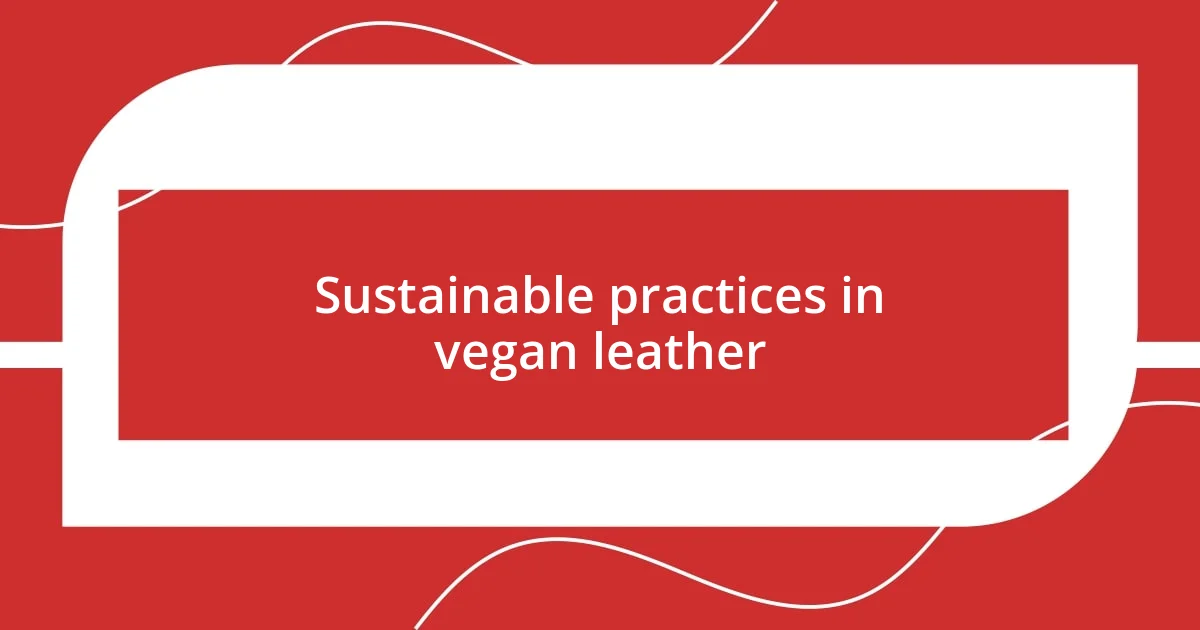Key takeaways:
- Vegan leather offers ethical and environmental benefits, with various materials like apple leather and Pinatex transforming waste into stylish alternatives.
- When selecting vegan leather, it’s crucial to consider the brand’s sustainability practices, material durability, and overall environmental impact.
- Leading brands in the vegan leather industry prioritize transparency in their production processes, contributing to a more circular economy and encouraging consumer accountability.

Understanding vegan leather options
Vegan leather options have gained remarkable popularity as more people seek sustainable and ethical alternatives to traditional leather. I remember the first time I held a piece of plant-based leather—its texture was surprisingly soft and luxurious, making it hard to believe it wasn’t made from animals. Isn’t it fascinating how innovation can lead to materials that not only mimic the look of leather but often surpass it in terms of environmental impact?
There’s a variety of materials used in vegan leather, ranging from synthetic options like polyurethane (PU) to innovative ones made from pineapple leaves or apple peels. I’ve often wondered how these natural materials hold up over time. From my experience, I’ve seen that while they can be durable, it’s essential to research brands to ensure they use high-quality processes that prevent issues like peeling or fading.
Additionally, while vegan leather offers ethical advantages, we should also consider its environmental footprint. I once came across a study that highlighted how some synthetic leathers can release harmful toxins during production. It made me think—what does sustainability truly mean? Balancing the benefits of animal welfare with eco-conscious choices can be complex, but with a bit of exploration, it’s possible to find options that align with both our values and our lifestyles.

Types of vegan leather materials
The world of vegan leather materials is diverse and continually evolving. From my exploration, I’ve come across several exciting options. One standout for me is the use of apple leather, which is derived from the waste of apple production. When I first learned about this, I was blown away by how we could turn by-products into a fashionable alternative. It feels good to know that, in a way, we’re giving new life to something that would otherwise go to waste.
Another intriguing material is Pinatex, made from pineapple leaf fibers. While I hadn’t initially expected to find leather-like properties in a plant, the durability and texture of Pinatex completely changed my perception. I remember trying out a pair of shoes made from this material; they not only looked great but were surprisingly lightweight and breathable. It’s these experiences that illustrate how sustainable choices can also be stylish and practical.
On the synthetic side, we have polyurethane (PU) leather, which is often praised for its affordability and versatility. I recall purchasing a vegan leather jacket made from PU; it was soft and had a high-end finish. However, this material doesn’t come without concerns, as its production can be environmentally taxing. Thus, it’s essential to weigh the benefits and drawbacks of each type of vegan leather to find what fits best for both our conscience and our closet.
| Type of Vegan Leather | Material Source |
|---|---|
| Apple Leather | By-product of apple industry |
| Pinatex | Pineapple leaf fibers |
| PU Leather | Polyurethane (synthetic) |

Benefits of choosing vegan leather
Choosing vegan leather comes with a myriad of benefits, and I must say that exploring these options feels quite liberating. For starters, the reduction of animal cruelty and suffering is a powerful motivator for many. I remember attending a workshop where an animal rights activist shared heartbreaking stories of factory farming. It hit home for me, and I walked away with a renewed commitment to support cruelty-free alternatives. Beyond ethics, vegan leather often requires lower energy and water for production compared to traditional leather, making it a more eco-conscious choice overall.
Here are some specific benefits of choosing vegan leather:
- Ethical Considerations: Choosing vegan leather helps eliminate animal exploitation.
- Environmental Impact: Many vegan leathers have a smaller carbon footprint than traditional leather.
- Sustainability: Materials like apple leather and Pinatex utilize waste and renewable resources, promoting a circular economy.
- Variety and Style: The range of textures and colors in vegan leather options can exceed those found in conventional leather, offering consumers more choice.
- Maintenance: Vegan leather is often easier to clean and maintain, providing practical benefits for everyday use.
I’ve also noticed that opting for vegan leather allows me to connect with brands that prioritize sustainability and ethical practices. The first time I bought a vegan purse made from recycled materials, I felt proud to support a brand that aligns with my values. It’s a subtle reminder that our choices can drive positive changes in the industry. With each piece I add to my collection, I feel as though I’m contributing to a movement toward more humane and environmentally friendly fashion.

Comparing vegan leather brands
When comparing vegan leather brands, I find myself drawn to the stories behind each material and manufacturer. For instance, I recently tried a wallet made from mushroom leather, which completely captivated me. The texture was surprisingly soft and had a unique appearance, almost like it had its own personality. It got me thinking—how often do we connect with the actual source of our products? Each brand has its own journey, and understanding that journey adds a layer of depth to my purchasing decisions.
Another brand that stood out to me is made from recycled ocean plastic. I remember seeing a social media post showcasing their production process, where they transformed discarded waste into sleek accessories. Just imagining those materials being rescued from the ocean and turned into something stylish made me appreciate the brand’s mission even more. It’s stories like this that make me consider the broader impact of my choices. Can a product truly be vegan if it’s not also environmentally conscious?
Lastly, I’ve discovered that not all vegan leathers are created equal in terms of durability. While some brands offer stunning designs, I’ve had experiences where the materials wore out quicker than expected, leaving me frustrated. One time, I purchased a pair of shoes that looked fantastic, but I ended up replacing them sooner than I would have liked. This taught me that evaluating a brand’s reputation for quality is just as important as the ethics behind the material. I often wonder, how do I balance style, sustainability, and longevity when searching for vegan leather options? Through exploration and experience, I’ve realized that the best choices come from a combination of beauty, responsibility, and durability.

Sustainable practices in vegan leather
Sustainable practices in the vegan leather industry are fascinating to explore. For instance, I recently discovered a brand that incorporates the waste from apple production to create their vegan leather. It amazed me how they turned leftover fruit into a stylish material! It sparked a thought—how often do we overlook the potential of what would otherwise be discarded?
In another recent experience, I visited a workshop that focused on creating bio-based leathers from plant materials like mushrooms and pineapples. Seeing the creative process in action was eye-opening, and I couldn’t help but feel a sense of hope for innovation in sustainable fashion. It made me really ponder how these practices contribute not just to sustainability, but also to a more circular economy. Have you ever considered that the products we choose can give a second life to what would typically be waste?
I also appreciate how leading vegan leather brands prioritize transparency in their sourcing and production processes. I remember reading labels on a pair of shoes that boasted a carbon-neutral certification. Knowing that my purchase left a smaller eco-footprint was rewarding. It got me wondering—what if more brands adopted this approach? The more we demand accountability and sustainability, the more the industry will adapt to our values. Embracing vegan leather isn’t just a personal choice; it’s a collective shift towards a brighter, more sustainable future.















